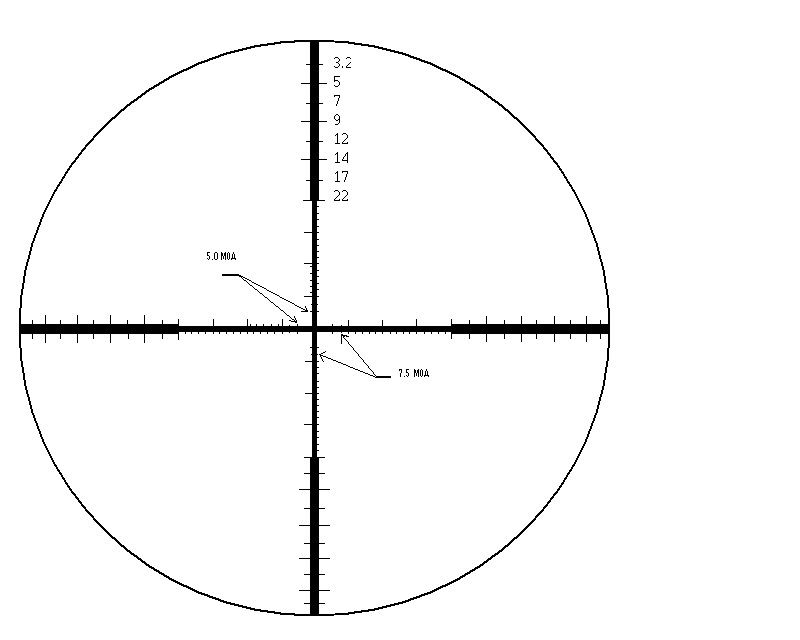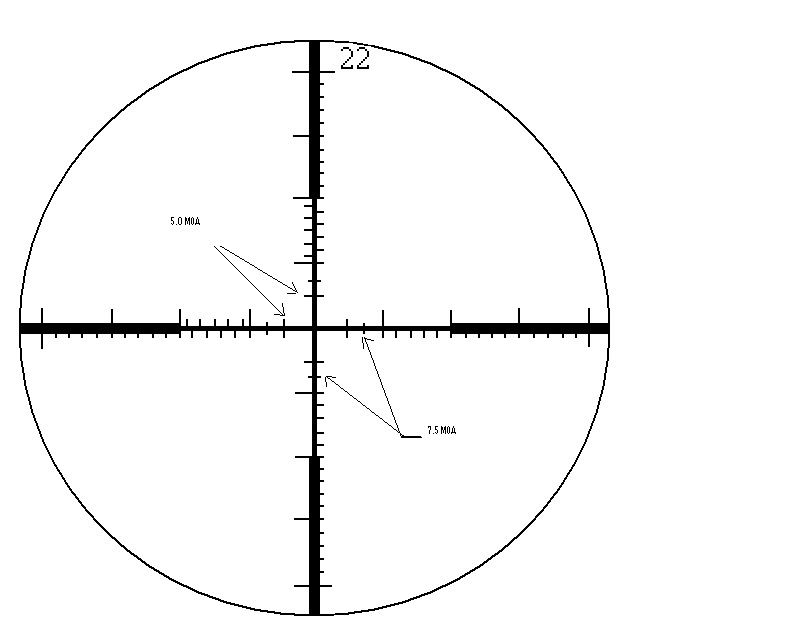Re: FFP ranging reticle with static-size cross-hair? Any interest?
<div class="ubbcode-block"><div class="ubbcode-header">Originally Posted By: ChielScape</div><div class="ubbcode-body">Hello guys. First post, and surprisingly short time lurker here. (Normally I stay quiet and read for a good while, but this thread got me too interested.)
I took some of the ideas from this thread, added some of my own, and came up with the following reticle. I apologize in advance for the crappy pic, but my 2D CAD software has no real decent image exporting function, it's quite basic, so I played around in Photoshop a little bit.
<span style="font-style: italic">"The reticle evolved to Dual Focal Plane. The red crosshairs and chevron are in the second focal plane, and thus remain the same size. The mil hashes and the magnification level marks (black) are in the first focal plane, and thus change with adjusted magnification. This combines the advantages of both focal plane configurations for those parts of the reticle that can best use it, and allows for some cool new features.
The chevron is your main aiming point, and should thus be clearly visible at all magnification levels to be able to use it's sharp aiming tip.
The crosshairs on FFP scopes either get too thin on low magnification, or too thick on high magnification, sometimes even both. The second focal plane keeps these lines at exactly the right thickness at all times.
Of course ranging and holdovers should work at all magnifications, so these are located in the FFP. These too can have the problem of becoming too thin at lower magnifications, so that's why the 5 and 10 mil marks have thicker bars at the ends. They keep their thin line crossing the crosshairs, however, to still offer an accurate aiming point.
The reticle itself features 0.2mil dots between the chevron tip and the first mil mark. These are not visible in this image. From the first to the tenth mil, there are half-mil marks, and the 1 mil marks continue out to 40 mils.
The lines have thickness of 0.025 mils, which is little under an MOA. The thicker bars have a thickness of 0.1mil. The same goes for the thin and thick portions of the crosshairs, at max magnification. At that point, the chevron is also 0.025mils thick. At 4x these values would be 0.5 and 0.125 mils respectively.
The half-mil marks are 0.25 mils long, the single mil marks are 0.5mils, while the 5 and 10 mil marks are 2 and 3 mils long respectively."</span>
That is the text I wrote to accompany the picture. It speaks of an evolved reticle and that makes more sense when I tell you I made a few reticles just a day or so before reading this thread, because I already had a few ideas of my own.
More pictures and explanations of previous reticles and how I iterationally improved them
HERE.
Please give me your thoughts. </div></div>
This concept is exactly what I think of when I envision my perfect long range scope (caveat, I'm new to long range shooting, so may be stupid).
Even without getting into the potential problems of a dual focus plane reticle, I don't understand why the reticle doesn't just get smaller as you get closer to the center?
Why not have the last .1 mil of the cross-hairs half as thick? or the last .3 half as thick, and the final .1 half of that? It's an obvious solution to an obvious problem. Is it just more expensive to do etching that fine?









